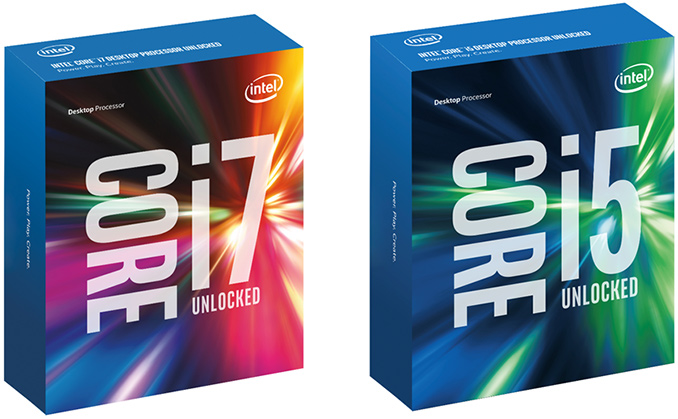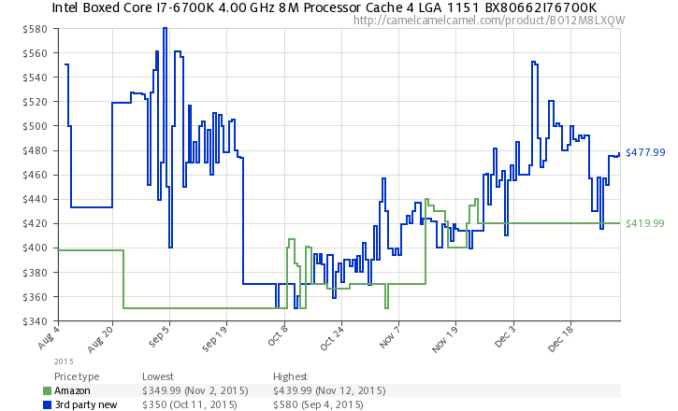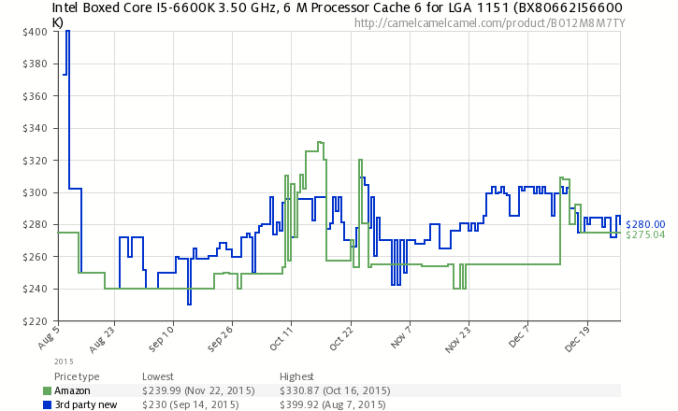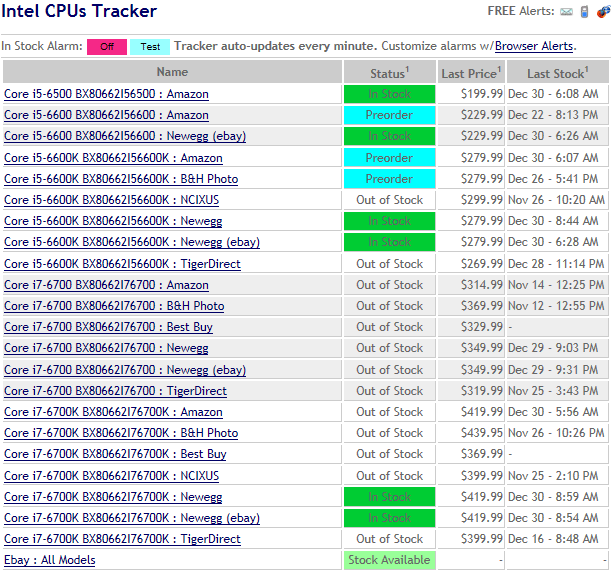Price Check: Intel's Core i7-6700K CPU In Short Supply
by Anton Shilov on December 30, 2015 8:00 AM EST
Demand for Intel’s Skylake CPUs has been very high since the introduction of the company’s latest processors in August. Even though the manufacturer has ramped up the supply of its Skylake CPUs since its launch, not all users can get these new CPUs. In fact, demand for higher-end Core i5-6600K and Core i7-6700K is so high that retailers recently increased prices of such chips. As a result, the quad-core top-of-the-range Skylake-S microprocessor is now more expensive than even the previous-generation six-core Haswell-E series.
Officially, the recommended customer price of one boxed Intel Core i7-6700K processor (four cores with Hyper-Threading, 4.0GHz/4.20GHz, 8MB cache, Intel HD Graphics 530 core, unlocked multiplier) is $350, according to Intel’s ARK. The recommended price of the Core i5-6600K chip (four cores, 3.50GHz/3.90GHz, 6MB cache, Intel HD Graphics 530 core, unlocked multiplier) is $243. However, at the moment it is not easy to buy thse CPUs without overpaying in the U.S. In fact, not all retailers even have the chips in stock, something that rarely happens to products released over three months ago.
For their part, Amazon does not currently have any Intel Core i7-6700Ks directly in stock. Instead the only 6700Ks available via Amazon are through their third-party marketplace sellers, starting at $499.99, which is nearly $150 higher than the recommended customer price. According to CamelCamelCamel, a price-tracker that monitors Amazon and its partners, the price of the chip began to increase in early October. Meanwhile Newegg sells the Core i7-6700K for $419.99, a smaller increase than Amazon but still higher than both Intel's original price recommendation and the price Newegg was charging at launch. Looking at Newegg's pricing history over at PriceZombie, it looks like Newegg increased the price of the chip beginning in November.
As for Intel’s Core i5-6600K, it's available at Amazon and Newegg for $289.99 and $279.99, respectively. The price of the chip has been fluctuating in both stores and at present the product costs slightly above its $243 MSRP.
Given these prices, it is noteworthy (and somewhat surprising) that Intel’s Core i7-5820K processor (six cores with Hyper-Threading, 3.30GHz/3.60GHz, 15MB cache, unlocked multiplier) is down to $389.99 these days, which makes it cheaper than the Skylake 6700K. The fact that the 5820K has to be paired with more expensive LGA2011-3 motherboards as well as quad-channel memory kits ultimately drives up the price of the total kit compared to a Skylake system, but that a still very performant hex-core CPU (ed: with solder!) is cheaper than Intel's flagship quad-core is something we rarely see. If nothing else it's a sign of just how unbounded quad-core pricing has become, though at the same time it thankfully provides a reasonable alternative to the 6700K and some counter-pressure to keep i7 prices from getting even higher.
When we asked Intel about what was going on with Skylake prices, they said in an emailed statement that they had not increased the MSRP of the 6600K/6700K - in other words, they had not increased prices on their end. Instead they suggested that select stores might have increased their prices because of strong demand for such chips, which is a pattern we've seen before with video cards and other components.
It goes without saying that retailers do not usually increase prices without a reason, as the intense competition among the online PC component retailers makes it difficult to hold too large of a margin under normal circumstances. All of this in turn points to an insufficient supply of microprocessors, with demand significantly exceeding supply. In fact, according to Nowinstock, which monitors availability of various products, many well-known U.S.-based stores did not have high-end Intel Skylake CPUs in their stocks at press time.
Intel has previously mentioned that the costs of producing CPUs on their 14nm manufacturing process were higher than the costs of 22nm CPUs due to initially lower 14nm yields. However, the company has never revealed whether yields are a reason why higher-end Skylake-S processors are currently in short supply, or if the problem lies elsewhere in the production chain. With any luck we may find out a bit more once Intel hosts their next earnings conference call in January.













103 Comments
View All Comments
emn13 - Sunday, January 3, 2016 - link
I have a system like you describe, though based on haswell, not skylake. When I researched components, it looked like sandy bridge would have worked just fine too - for a silent PC, you care more about the maximum sustained power load rather than the idle power usage, because you need to be able to cool that maximum load. And maximum power usage hasn't really dropped much - TDP's are down from 95W (2600k) to 91W (6700k) - i.e. essentially not at all.enmass90 - Wednesday, December 30, 2015 - link
Nehalem?! I would argue that CPU's haven't really been a bottleneck for most people since Wolfdale.Rocket321 - Thursday, December 31, 2015 - link
My Wolfdale (3ghz, dual-core, 6GB Ram, 8800GT) is starting to show its age with graphic heavy web pages being slow to load and not being able to play 1080p60 content on youtube. Obviously can't run the latest games very well. So as of this year I'd say its time to upgrade any Core2duo systems.anandreader106 - Saturday, January 2, 2016 - link
I'm pretty sure that has more to do with your 8800GT.jjj - Thursday, December 31, 2015 - link
The DIY market is not for regular people and it's not gaming only either. The big problem is the lack of additional cores at sane prices, the pointless GPU. But many more other thing cripple this market ( like too few PCI lines), pretty much everything Intel does is aimed at higher profits but at the same time they are hurting the market.In 2012 the mobo market was some 80 million units ,it's just crashing hard. We are buying GPUs and SSDs and RAM and anything that's appealing but on the CPU side there is nothing. Intel is just killing the mobo makers, the case makers, PSU makers. Even if you argue some saturation in developed nations, the developing markets had different dynamics and the was room for nice growth. Hopefully Zen is good and AMD aggressive , forcing Intel to offer more too but remains to be seen, AMD could focus on high margins instead of big share gains.
StrangerGuy - Saturday, January 2, 2016 - link
The simple truth is that people who needs hardware beyond a Sandy Bridge Quad + single GPU + SATA3 SSD + basic USB3 are a niche within a niche. Skylake / DDR4 offers nothing compelling to these vast majority of desktop users for the added price.Samus - Thursday, December 31, 2015 - link
I agree. Since Nehalem, the IPC improvements haven't really been beneficial to most users. The real benefits have been in the chipset.This is where Intel shot itself in the foot. In order to drag out Haswell because of process node delays, they released Skylakes' chipset for Haswell as the 90-series, while making virtually no changes except to the socket and reimplementing FIVR on the 100-series.
So people upgrading from a recent Haswell platform are getting almost no chipset improvements and few IPC improvements. Considering Haswell systems cost over a hundred bucks less than that of a comparable Skylake system (a Z97 board with USB 3.1 and m.2 costs nearly half that of a Z170 equivilent) I'm surprised there is that much demand as well...and it's more likely a supply issue.
Since the launch price was so high to begin with (higher than most recent Core i5/i7 launched) it becomes pretty obvious the margins aren't favoring Intel like they'd prefer due to poor yields.
patrickjp93 - Monday, January 4, 2016 - link
Poor yields? Intel wouldn't be making 700 mm sq. Knight's Landing chips if yields were poor. This is all demand.mapesdhs - Wednesday, December 30, 2015 - link
This sort of thing just makes used builds even more attractive. 6700K is nice for sure, but I saved 200 UKP building an X79 with a 3930K instead. High pricing on current CPUs will only harm desktop sales even more in the coming year.nathanddrews - Wednesday, December 30, 2015 - link
I really like my 3570K build, but if I could go back, I would have gone with a hex-core model w/HT. Next time, Gadget, next time...